Your brain is lying to you right now.
These mystical entities you encounter aren’t some cosmic revelation—they’re the fireworks display your mind puts on when it’s backed into a corner. Meditation, psychedelics, trauma, spiritual practices—they all crack open doors your mind normally keeps locked for your own protection.
Picture this: You’re deep in meditation. Something appears. A being of light, perhaps, or your dead grandmother offering wisdom. Maybe aliens probing your consciousness or demons threatening your soul. The experience feels more real than this morning’s breakfast—more real than the words you’re reading now.
Your heart races. Your consciousness expands. Something profound has happened. You’ve been chosen, contacted, blessed or cursed…
…or you’ve just witnessed your mind’s most impressive magic trick.
The Experience Is Real, The Interpretation Is Not
Your experiences happen. This much cannot be denied.
When consciousness shifts and entities appear, what occurs is an actual experience in your awareness—a phenomenon as valid as seeing a tree or feeling the sun. The question isn’t whether something happened but what that something actually was, and the territory between experience and interpretation is where most seekers lose their way.
Consider Linda, devoted meditator and workshop junkie. After years of practice, she encounters a radiant being who identifies itself as her “spirit guide.” The entity offers specific advice about her life path. Linda is ecstatic, telling everyone about her guide, following its instructions, even making life decisions based on its wisdom. She’s convinced of its independent existence—a spiritual breakthrough, not a mental creation. What Linda misses is the crucial distinction between the raw experience (lights, sounds, presence, communication) and her interpretation (external being, objective reality, cosmic significance). Her mind has constructed a narrative that feels good, feels special, reinforces her spiritual identity.
But raw experience requires no story. The lights, the message, the presence—these are just phenomena arising in consciousness, no different from a stomach growl or a passing thought. The minute you wrap them in meaning, you’ve left direct experience for the comfort of explanation…
…and explanations are where truth goes to die.
Your Mind Projects What You Expect
The mind manufactures reality according to its programming.
What appears during your spiritual episodes depends largely on the conceptual frameworks you’ve absorbed throughout your life. The mental software you’re running determines what entities show up on your consciousness screen, a fact that should immediately make you suspicious of their objective existence.
A Buddhist monk doesn’t encounter Jesus. A Catholic nun doesn’t meet Lord Krishna. A UFO enthusiast doesn’t see angels. And a hardened materialist doesn’t see entities at all. Your mental construct creates entities that fit neatly within your existing belief structure, tailored to your expectations like a bespoke suit. This isn’t cosmic reality—it’s personalized entertainment. Think about children who have “imaginary friends.” We patronize them, knowing these friends aren’t “real.” Yet when adults have their own imaginary friends—angels, guides, entities—we suddenly treat these projections with reverence. We create elaborate systems to explain them, build religions around them, start wars over competing versions.
The mind’s capacity for projection isn’t just powerful—it’s nearly unlimited. It can create entire universes inside your skull, complete with characters who seem to have their own agendas, personalities, and wisdom. Your consciousness becomes both the movie screen and the projector…
…showing films you forgot you wrote and directed.
Dream Characters Don’t Exist When You Wake Up
Dreams feel absolutely real until you wake up.
During sleep, you interact with people who feel completely autonomous—they surprise you, teach you, threaten you—yet upon waking, you understand they were projections of your own mind. Why would you assume the entities you meet in meditation or psychedelic states are any different from these dream characters?
Jack took ayahuasca and met a serpent deity who showed him the interconnectedness of all life. The experience transformed him. Years later, he still speaks of this serpent as an independently existing being that “chose” to reveal itself to him. But Jack never questions a critical point: if this serpent deity exists independently, why does it only appear to people who ingest specific chemicals that alter brain function? The dream analogy punctures our spiritual pretensions. In dreams, we create complex worlds and beings without effort. We accept their reality completely—until we wake up. Similarly, in altered states, we generate entities that feel real, but the state itself is temporary. When it ends, the entities vanish.
This doesn’t make the experience meaningless. Dreams can contain profound insights precisely because they bypass our rational filters. But mistaking the messenger for the message misses the point entirely. The value lies in what you learn, not in the projected form that delivered it…
…just as dream wisdom can be real even when dream characters aren’t.
Your Ego Loves Having Cosmic Friends
Your ego craves significance above all else.
Mystical encounters feed the ego a five-course meal of cosmic importance. When “higher beings” single you out for contact, you’re no longer an ordinary person—you’re chosen, special, initiated into hidden knowledge. Your spiritual resume gets an impressive bullet point that sets you apart from the spiritual masses.
Sarah joined a channeling circle where participants connected with deities and ascended masters. She quickly became the group’s star, channeling an entity named Zorya who offered protection from dark forces. Sarah’s social status soared. People sought her advice, praised her connection, treated her with reverence. What Sarah never examined was how perfectly Zorya’s messages aligned with her own unconscious desires for recognition and authority. The ego is crafty. It will hijack even the most genuine spiritual experiences to strengthen itself. “I was contacted” becomes a powerful identity marker, elevating you above those who haven’t been “chosen.” This special status becomes addictive—a spiritual achievement badge you can display to others and yourself.
The irony is brutal: experiences that could potentially dissolve the ego instead become its most potent reinforcement. Your spiritual encounter, rather than liberating you from self, becomes the self’s most treasured possession. The experience becomes a spiritual trophy…
…and trophies always need polishing and protection.
Nothing Is More Or Less Real Than Anything Else
Reality itself is the primary illusion.
From the perspective of non-duality, the entire debate about whether entities are “real” misses the fundamental point. Nothing perceived has independent existence—not the chair you’re sitting on, not your thoughts, not the angelic being in your vision. All are appearances in and as consciousness.
Consider two people: Michael encounters angels during meditation while Lisa sees only mental imagery. Michael insists his angels are “real beings” while Lisa’s experiences are “just imagination.” Both miss the essential truth that everything experienced—whether seemingly material or seemingly mystical—exists as appearance in consciousness, neither more nor less real than the other. The apparent solidity of physical objects is no more “real” than the apparent wisdom of a spirit guide. Both are interpretations of raw experience, conceptual overlays on the immediacy of awareness. The tree outside your window and the angel in your vision share the same ontological status—both appear in consciousness, both are known only through perception.
When you grasp this, the question shifts from “Are these entities real?” to “What is the nature of reality itself?” This is where true spiritual inquiry begins—not with cataloging supernatural encounters, but with investigating the consciousness in which all phenomena, ordinary and extraordinary, appear…
…and in which you, the apparent experiencer, also appear.
Beyond the Entity Trap
Your obsession with entities misses the point entirely.
Getting caught in debates about the reality status of angels, aliens or guides is like arguing about which character in a movie deserves an Oscar—it misses the fact that they’re all just images projected on a screen. The projector is what matters, not the temporary forms it creates.
The real invitation of these experiences isn’t to build relationships with cosmic beings or to collect mystical merit badges. It’s to recognize the awareness in which all experience occurs—the knowing presence that contains both your everyday world and your most profound mystical encounters. This knowing doesn’t belong to you; rather, you appear within it. When you shift focus from the content of experience to the context of awareness itself, entities lose their grip on your imagination. They’re neither dismissed as “not real” nor elevated as “more real”—they’re simply recognized as appearances, no different from thoughts, sensations, or material objects.
This recognition doesn’t diminish the wonder of life—it expands it. Every moment becomes a mystical encounter when you see that ordinary reality is just as miraculous, just as unexplainable, just as mysterious as any angelic visitation or alien abduction. The extraordinary isn’t elsewhere…
…it’s what’s reading these words right now.
So Are These Entities Real?
They’re exactly as real as you are—which makes for one hell of a playground.
Go ahead and dance with angels, debate demons, receive transmissions from star beings. The cosmic theater is open and the show is spectacular. Just remember that the most mind-bending plot twist awaits when you finally turn around…
…and see who’s been watching the show all along.


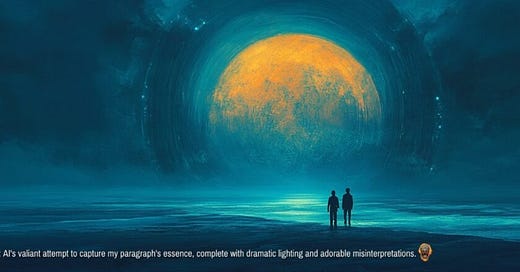




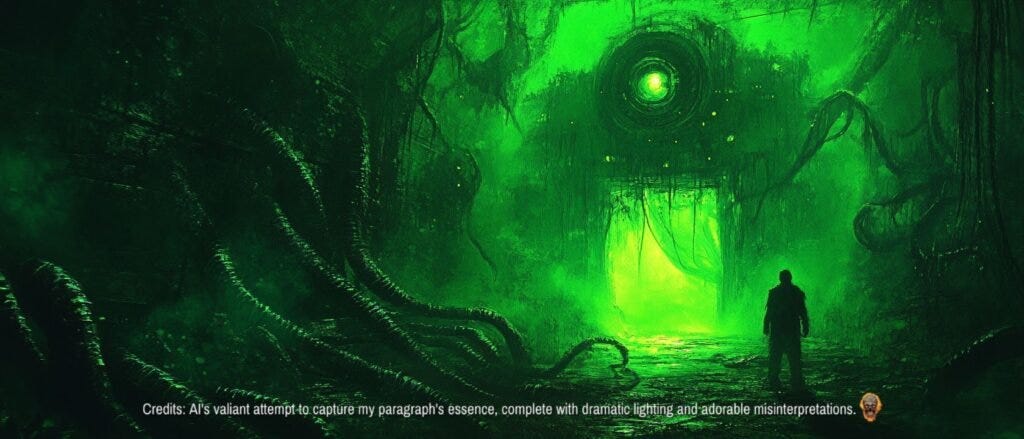
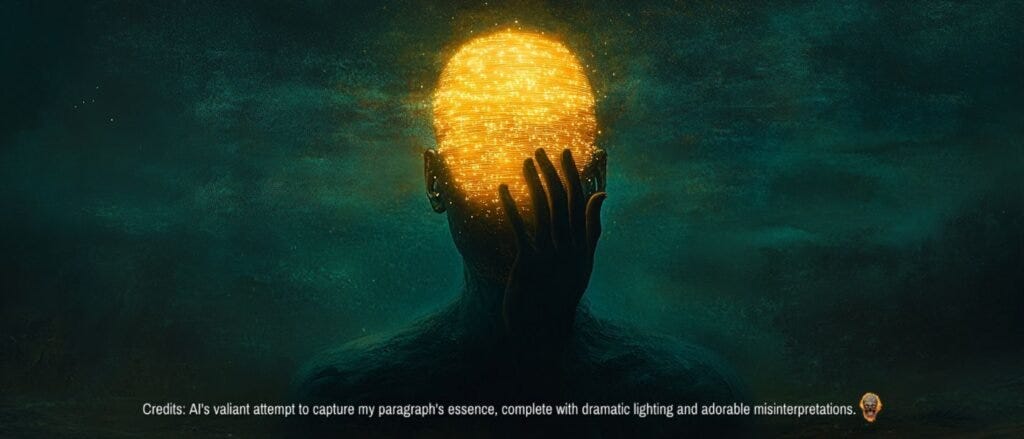

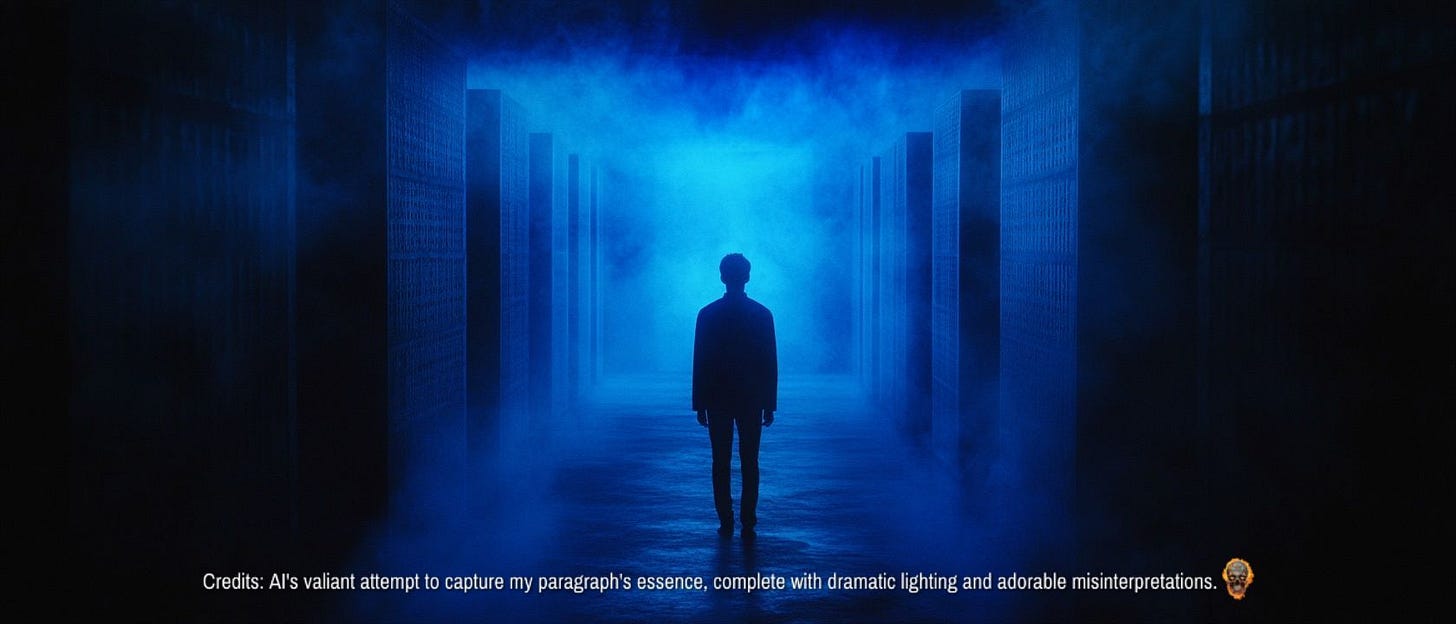
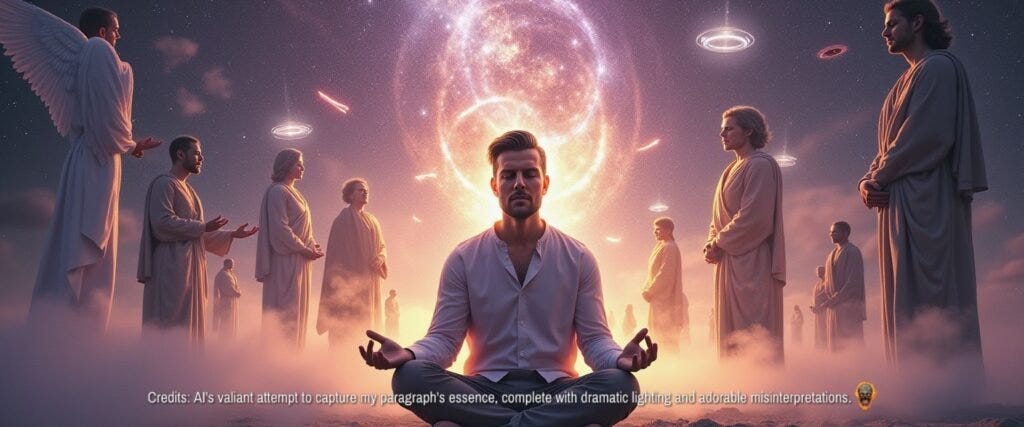
You are on a roll with the writing!
"All that we see or seem
Is but a dream within a dream." Is the dream within the dream character capable of recognizing that it is dreaming? I wish I could ask Poe.